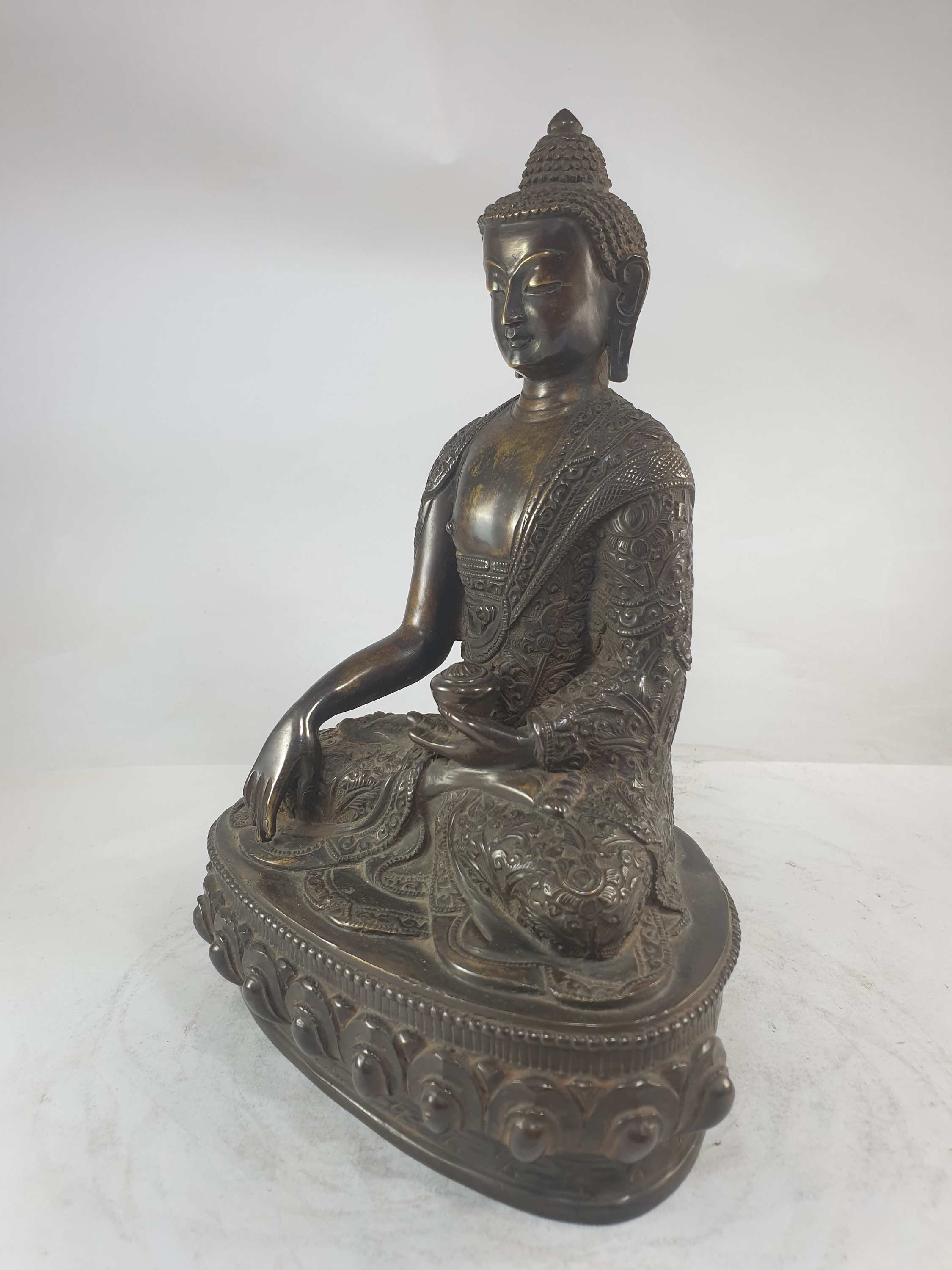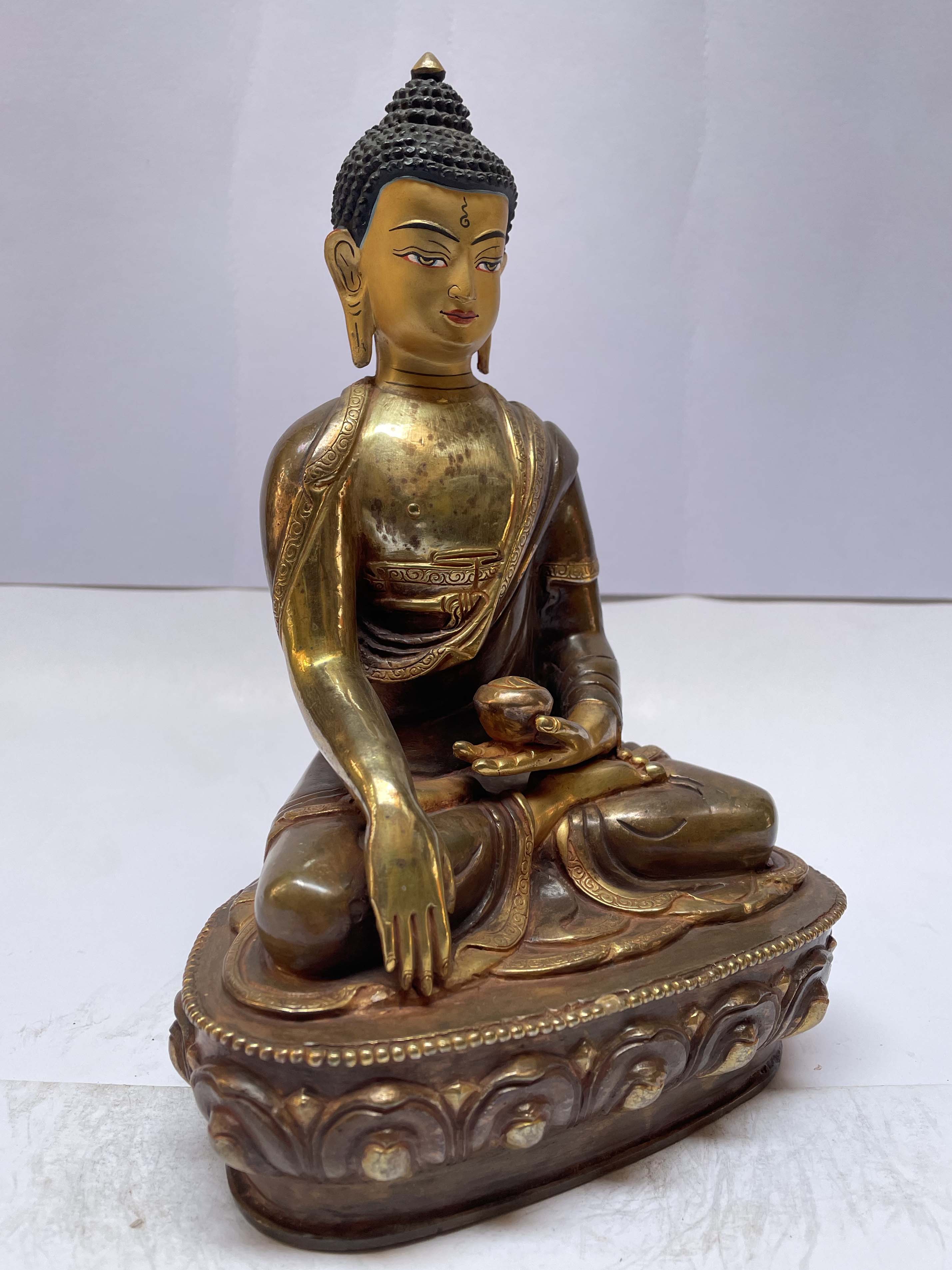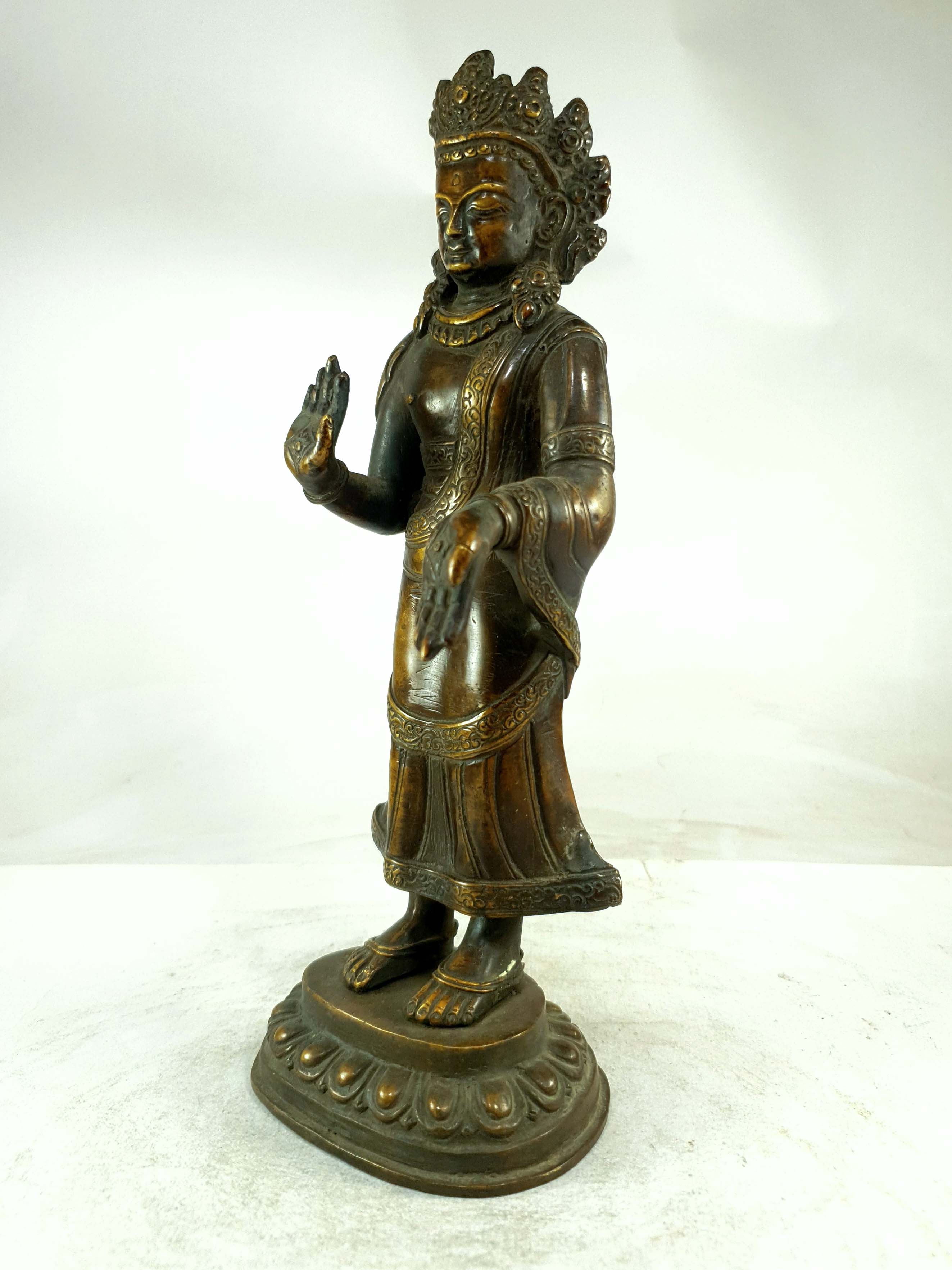Code
HCS31573
Weight
672 gm / 1.48 lbs
Size
Height
23cm (9") Width
14.5cm (6") Depth
8cm (3") Material
Copper
Availability
Available

Safe Payment
We accept Paypal, Money Transfer, Bank Transfer
Confidence
Protection covers your purchase and personal data.
Worldwide Delivery
We ship Worldwide, except Russia.Shipping cost US$25.2 for upto 0.5 kgs

Hotline
Talk to help line for your question on 9841267335Gold Painted Face
The face of [amitabha Buddha], Buddhist Handmade Statue, [face Painted] And [gold Plated] is painted with gold to enhance its significant features, particularly the eyes, and lips. This detailed painting is essential as it brings forth the crucial attributes of the expression of eyes and lips that metal carving alone cannot capture.
Moreover, the painted face serves as a symbolic and sacred ritual in Buddhism, preparing the statue for consecration and practice. The act of painting the face with gold in Buddhism holds deep meaning. It represents the intention to bring life and expression to the statue, imbuing it with a sense of vitality and presence. The application of gold on the face showcases the devotion and craftsmanship of the artisans, ensuring that every detail is carefully attended to honor the sacred essence of the [amitabha Buddha], Buddhist Handmade Statue, [face Painted] And [gold Plated]. Read More . . .
The face of [amitabha Buddha], Buddhist Handmade Statue, [face Painted] And [gold Plated] is painted with gold to enhance its significant features, particularly the eyes, and lips. This detailed painting is essential as it brings forth the crucial attributes of the expression of eyes and lips that metal carving alone cannot capture.
Moreover, the painted face serves as a symbolic and sacred ritual in Buddhism, preparing the statue for consecration and practice. The act of painting the face with gold in Buddhism holds deep meaning. It represents the intention to bring life and expression to the statue, imbuing it with a sense of vitality and presence. The application of gold on the face showcases the devotion and craftsmanship of the artisans, ensuring that every detail is carefully attended to honor the sacred essence of the [amitabha Buddha], Buddhist Handmade Statue, [face Painted] And [gold Plated]. Read More . . .
Full Fire Gold Plating
This [amitabha Buddha], Buddhist Handmade Statue, [face Painted] And [gold Plated] is finished with full gold plating. also known as mercury gold plating or fire gold plating. This traditional technique involves the application of a genuine layer of gold onto the [amitabha Buddha], Buddhist Handmade Statue, [face Painted] And [gold Plated]. Referred to as mercury gold plating, it is considered the correct and authentic form of gold plating in Nepal. Despite being more expensive than electroplating, this traditional mercury gold plating is gaining popularity again in Nepal. People are drawn to its authenticity, longevity, and the unmatched beauty it brings to the [amitabha Buddha], Buddhist Handmade Statue, [face Painted] And [gold Plated]. The resurgence of interest in this traditional form of gold plating reflects a growing appreciation for the craftsmanship and cultural heritage of Nepal Read More . . .
This [amitabha Buddha], Buddhist Handmade Statue, [face Painted] And [gold Plated] is finished with full gold plating. also known as mercury gold plating or fire gold plating. This traditional technique involves the application of a genuine layer of gold onto the [amitabha Buddha], Buddhist Handmade Statue, [face Painted] And [gold Plated]. Referred to as mercury gold plating, it is considered the correct and authentic form of gold plating in Nepal. Despite being more expensive than electroplating, this traditional mercury gold plating is gaining popularity again in Nepal. People are drawn to its authenticity, longevity, and the unmatched beauty it brings to the [amitabha Buddha], Buddhist Handmade Statue, [face Painted] And [gold Plated]. The resurgence of interest in this traditional form of gold plating reflects a growing appreciation for the craftsmanship and cultural heritage of Nepal Read More . . .
Lost-Wax System
This Buddha of [amitabha Buddha], Buddhist Handmade Statue, [face Painted] And [gold Plated] is made by the process of the Lost Wax system. This is a very complicated, time consuming and historic process of making metal sculptures.Which is why it is sometimes called Precision Casting as well. Hence the sculptures made by this process are comparatively expensive. There are many new, advanced and less time consuming methods of casting metal sculptures available as well. But due to the benefits provided by the traditional lost wax system in quality control and customization, we prefer the Loss wax system over Ceramic molding, or sand casting to make our Buddha.
Below we have tried to illustrate the process of making a loss wax system statue: Read More . . .
This Buddha of [amitabha Buddha], Buddhist Handmade Statue, [face Painted] And [gold Plated] is made by the process of the Lost Wax system. This is a very complicated, time consuming and historic process of making metal sculptures.Which is why it is sometimes called Precision Casting as well. Hence the sculptures made by this process are comparatively expensive. There are many new, advanced and less time consuming methods of casting metal sculptures available as well. But due to the benefits provided by the traditional lost wax system in quality control and customization, we prefer the Loss wax system over Ceramic molding, or sand casting to make our Buddha.
Below we have tried to illustrate the process of making a loss wax system statue: Read More . . .
Brief Introduction :
Amitabha is head of the Lotus Family, one of oldest & significant of the Five Buddha Families. This family represents love, purity, compassion & peace. Amitabha Purelandis a place of infinite bliss & boundless light. He will guide you along a path of simplicity and purity towards such a place where you can find inner contentment. Amitabha will help you overcome addictions and cravings.
Iconography :Amitabha Buddha is also one of the five Tathagatas representing the wisdom of discriminating awareness (skt. Pratyavekshanajnana). When discriminating wisdom dawns on us we realize Non-production or non-origination of all things. He also represents purified form of desire.
Amitabha Buddha is red in color. He is represented in the stupa facing to the west. He rides on peacock symbolizing that he can take away the suffering of others just as the peacock eats poisonous plants and yet his tail shines forth.
Amitabha in Sanskrit means immeasurable light or limitless light. He resides in the western land of unlimited bliss (skt. Sukhavati). He is assisted by two Bodhisattvas viz. Avalokiteshvara and Mahasthamaprapta. When he was a bodhisattva he was called Bhikshu Dharmakara. He made vows to establish an adorned land of unlimited bliss to ferry over those living beings who recite his name. On the basis of those vows, any living being who has faith, makes vows and practices diligently will be received by this Buddha and reborn in the pure land of unlimited bliss.
Amitabha Buddha presides over the Bhadrakalpa i.e. Fortunate Aeon. He always exhibits Dhyana mudra. He belongs to the Lotus family. He originates from the seed syllable Hrih. He can be recognized through the symbol of the lotus. With his extensive vows and great compassion this Buddha has ferried over innumerable sentient beings. The recitation of the name of Amitabha Buddha is a common practice in China and Japan. In Tibet too, devotees recite very often the prayer to be reborn in the land of Amitabha Buddha.urity
Commentary :Amitabha Buddha is red in color. He is represented in the stupa facing to the west. He rides on peacock symbolizing that he can take away the suffering of others just as the peacock eats poisonous plants and yet his tail shines forth.
Amitabha in Sanskrit means immeasurable light or limitless light. He resides in the western land of unlimited bliss (skt. Sukhavati). He is assisted by two Bodhisattvas viz. Avalokiteshvara and Mahasthamaprapta. When he was a bodhisattva he was called Bhikshu Dharmakara. He made vows to establish an adorned land of unlimited bliss to ferry over those living beings who recite his name. On the basis of those vows, any living being who has faith, makes vows and practices diligently will be received by this Buddha and reborn in the pure land of unlimited bliss.
Amitabha Buddha presides over the Bhadrakalpa i.e. Fortunate Aeon. He always exhibits Dhyana mudra. He belongs to the Lotus family. He originates from the seed syllable Hrih. He can be recognized through the symbol of the lotus. With his extensive vows and great compassion this Buddha has ferried over innumerable sentient beings. The recitation of the name of Amitabha Buddha is a common practice in China and Japan. In Tibet too, devotees recite very often the prayer to be reborn in the land of Amitabha Buddha.urity
The word 'Amitabha' is composed of 2 syllables. Amita-[Skt.] translates as infinite & -bha universal life or simply the universe. Related Sanskrit words include bha-va asin Bhavachakra & Bha-gavad as in Bhagavad Gita. Amitabha is often translated as Boundless Light which is taken to be the boundless Universe. Amitabha realised a Pure Land called Sukhavati which meanspossessinghappinessin Sanskrit. Sukhavati is situated in the uttermost west beyond the bounds of rational understanding. By the power of his vows he made it possible for all who call upon him to be reborn into this land, there to undergo instruction by him in the dharma and ultimately become bodhisattvas & Buddhas. Amitabha is one of the five Transcendent Buddhas emanated from the primeval 'Adi' Buddha Vajrdhara. Each of the transcendent Buddhas has arisen to help us overcome the five obstructions [Skt. Kleshas] to our spiritual growth and each is the Head of a Family. The Sanskrit word Klesha means poison in the sense of curruption. For this reason the transcendent Buddhas are called Wisdom Buddhas; they possess the wisdom to overcome viz. transcend the five obstructions are greed, hatred, delusion, jealousy & pride. Amitabha is formed to help us overcome greed [often expressed as desire]. Greed is conceived of as a thirst [Skt. Tanha] or appetite for the destructive things that harm us such as smoking, alcohol & selfishness. The transcendent Buddhas are sometimecalled the Meditation [Skt. Dhyana] Buddhas as people meditate on their wisdoms to overcome the five obstructions to spiritual growth to anable us to reach a higher level of understanding.
Mantra of Amitabha Buddha
Oṃ Amideva Hrīḥ


![[amitabha Buddha], Buddhist Handmade Statue, [face Painted] And [gold Plated]](https://handicraftseller.com/uploads/pics/product/thumb/2024/02/31573.jpg)
![[amitabha Buddha], Buddhist Handmade Statue, [face Painted] And [gold Plated]](https://handicraftseller.com/uploads/pics/product/thumb/2024/02/31573_0.jpg)
![[amitabha Buddha], Buddhist Handmade Statue, [face Painted] And [gold Plated]](https://handicraftseller.com/uploads/pics/product/thumb/2024/02/31573_1.jpg)
![[amitabha Buddha], Buddhist Handmade Statue, [face Painted] And [gold Plated]](https://handicraftseller.com/uploads/pics/product/thumb/2024/02/31573_2.jpg)


























































 of Shakyamuni Buddha
of Shakyamuni Buddha  of Shakyamuni Buddha
of Shakyamuni Buddha  of Shakyamuni Buddha,
of Shakyamuni Buddha,  of Shakyamuni Buddha,
of Shakyamuni Buddha,  of Shakyamuni Buddha,
of Shakyamuni Buddha,  of Dipankara Buddha,
of Dipankara Buddha,  of Dipankara Buddha,
of Dipankara Buddha,  Amitabha Buddha, Buddhist Handmade Statue,
Amitabha Buddha, Buddhist Handmade Statue,  Amitabha Buddha, Buddhist Handmade Statue,
Amitabha Buddha, Buddhist Handmade Statue,  of Maitreya Buddha
of Maitreya Buddha  of Maitreya Buddha
of Maitreya Buddha  of Shakyamuni Buddha,
of Shakyamuni Buddha,  of Shakyamuni Buddha,
of Shakyamuni Buddha,  of Medicine Buddha
of Medicine Buddha  of Medicine Buddha
of Medicine Buddha  Monastery Quality Statue
Monastery Quality Statue  Monastery Quality Statue
Monastery Quality Statue  of
of  of
of